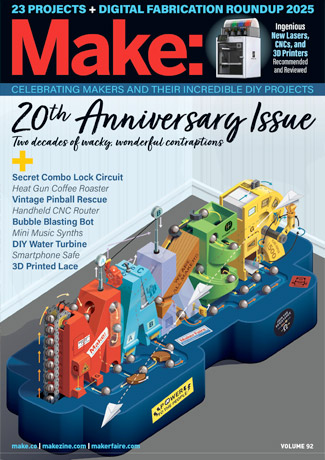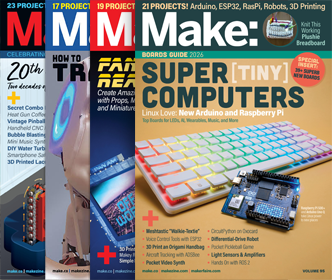

The allure of wearable computing has been with us almost as long as the personal computer. Look through old PC magazines and you’ll find ads for ahead-of-its-time hardware like The Private Eye, a ’90s-era head-mounted display (HMD). We can also look to early examples of DIY “cyborgs” like Steven Roberts, the “high-tech nomad,” Steve Mann, the “father of wearable computing” who’s lived as a computer-augmented human for the past 35 years, and Professor Thad Starner of Georgia Tech, coiner of the term “augmented reality,” who’s worn a HMD for the past 20 years. Starner even served as a technical lead on the Google Glass project. These maker pioneers didn’t bother to wait for Glass. They used the technology available at the time — costly, limited, and unwieldy as it may have been. They made the wearables they wanted to see in the world, as soon as they imagined them. And now, with the advent of Google Glass — the first widely available, affordable, net-connected computer glasses — today’s makers are being inspired to explore this emerging technology, to create their own alternatives, and to tear down, hack, and augment Glass itself.
So What Exactly IS Glass?
Basically, Glass is an Android computer that you wear like a pair of glasses. There’s a tiny head-mounted display in the upper right corner of your field of view and a touchpad that runs from your right eye to your ear along the stem. You use a combination of head gestures, touch, and voice commands to operate the system. The display is described as the equivalent of a 25″ hi-def screen from 8′ away. There’s a built-in 5-megapixel still and 720-dpi video camera, plus on-board wi-fi and Bluetooth so Glass can sync to your phone or a nearby network. Sensors include a 3-axis gyro, a 3-axis accelerometer, a 3-axis magnetometer (compass), and ambient light and proximity detectors. The latest version of Glass offers the option of adding prescription lenses to the (ironically) glassless Glass frame, plus an optional earbud (to use instead of the built-in bone-conduction audio).
The DIYers
As soon as the invitation-only “Glass Explorer” program was launched, enterprising makers around the world hit their workbenches and began cobbling together their own versions based on Google’s promotional media and early demos. Searching “DIY Google Glass” nets a bizarre catch of phony Glass-like display demos, ridiculously clunky proof-of-concept hardware experiments, and humorous takes on Glass, as well as a number of interesting, earnest homebrew HMD projects.
Nathan Myers

Myers sees potential applications for his glasses among the hearing-, sight-, and motion-impaired, as his project uses voice and (eventually) eye-tracking, not touch or gesture. He’s hoping to attract interest from investors so he can develop his ideas further. Myers originally called his project Flass (“Fake Glass”) but changed it to MiDisplay after a run-in with Google IP.
Rod Furlan

Furlan says that though he started out skeptical of the technology, after wearing it for awhile he began to feel attached — taking it off produced a noticeable sense of loss. Even though his build is crude by Glass standards, it still gave him a taste of what’s to come. You can read in more detail about Furlan’s build on spectrum.ieee.org.
John Dingley

on his head. Hooked up to his iPod Touch, Dingley is now free to move about the house, watching movies and TV while pretending
to be productive. His build is well-documented on Instructables.
Joris van Tubergen

Cyborg DIY
Like all wearable tech, the head-mounted display market has struggled for years to find a foothold. Consequently, numerous commercial HMD systems have come and gone. This has been unfortunate for widespread adoption of wearables but a boon to hardware hackers looking for cheap tech to cannibalize, hack, and reimagine. Historically, input devices have been a major stumbling block for HMDs. Once you start adding air mice, chord keyboards, and/or handheld or wrist-borne keyboards/track pads, you quickly end up with a system that’s too clunky to be practical. The advent of widespread and reliable speech-to-text and voice-command software may finally get us there; a practical HMD input system is no longer that difficult to achieve, even for DIYers, who can use voice-enabled phones and other devices for control.
Doing it Yourself
To create a bare-bones head-mounted display for your smart phone, all you really need is…
- A video display.There are a number of commercial video glasses out there. One of the more commonly hacked is the MyVu Crystal 701. It’s fairly easy to get one camera module and optics out of these glasses to use as a monocular HMD. Crystal glasses can be found on eBay and will run you from $100–$150, less if you get lucky. You’ll need to remove the camera module and optics for one lens and the cabling/connector.
- Something to mount it on. 3D-printed frames (see Joris Van Tubergen), or possibly your prescription glasses.
- Something to mount it with. Glues, screws, zip-ties, rivets, thumbtacks, possum spit, or whatever else gets the job done.
- Cables/connectors/adapters. As needed to get your display to connect to your phone.
- Voice-control software. Siri-equipped iPhones work pretty well for a lot of voice nav functions (and there are apps like Hands-Free Control that allow you to awaken jailbroken phones with a voice command). You can also use the button control on your headset to access Siri. On an Android, there are apps such as Utter and Tasker.
The Hackers
Among makers lucky (and well-heeled) enough to gain early access to Glass through the Explorer program, quite a few impressive hacks, mods, and augmentations have appeared.
Deqing Sun

Building on his success with “GlassLight,” Sun developed “Glass Trinket,” a project that uses Glass as a USB host for Adafruit’s tiny, inexpensive “Trinket” mini AVR microcontroller board. Connecting an external microcontroller opens up all sorts of possibilities for additional sensor input and other augments. Predator-style heat vision, anyone?
Sun has also built a Glass remote control for use in very windy conditions, while wearing a scarf, in extreme cold, or when otherwise unable to use voice input. It’s built around Adafruit’s Bluefruit EZ-Key keyboard controller. More details are available over at Adafruit.
Brandyn White

Other projects by White’s group have included a $25 eye-tracking unit that mounts to Glass, an exclusively eye-controlled Mario Bros. video game, a Makey Makey-based Glass input controller, head- and touch-gesture-based Arduino and servo control, and Glass-based animatronics. They also created a pair of applications designed for use by the visually impaired: Question-Answer uses “cloud workers” to answer visual “what is this?” questions, and Memento compares streamed video frames against a database of images with descriptive voice annotations, which are read back to the user. “We are all very excited about the potential of wearable computing,” enthuses White. “The companies that make these devices are often focused on their own products. What we want to do is help fill in
the gaps with free software, and hopefully, push things forward a bit faster.”
“Not OK, Glass”
Given that Glass can so easily and surreptitiously take photos and videos without those around knowing it, the technology has raised a lot of privacy jitters. Some bars and restaurants in Silicon Valley have even started posting “No Glass” signs. Artist and engineer Todd Blatt was quick to respond to these concerns (and poke a little fun at the Glass phenomenon at the same time) by creating a line of 3D-printed accessories. These include a brightly colored camera lens privacy shield (so people can see your camera is blocked), an old school “On Air” sign, and some other whimsical add-ons like cyborg-targeting crosshairs. Blatt says his original inspiration was the privacy shield (which he calls GlassKap), “But why stop there? If anticipating Glass has taught us anything, it’s that people have bold aspirations when it comes to tricking out their tech. Once I began, ideas flowed like Klingon Blood Wine.” Check out more of Todd’s work at custom3dstuff.com.
If You Come, They Will Build It
Before anyone had donned Glass, Rod Furlan had already cobbled together his own HMD and tested the impacts of regularly wearing such a device, drawing his own (slightly different conclusions) as to why it’s relevant. Early on, he concluded that the real utility of Glass was going to be in the photographing and recording aspects, more than augmenting reality. Furlan imagines a future in which you record everything you do and can then play back your memories — an idea he calls “augmented cognition.” Though Google plays down the recording/photographing aspect over the AR features, augmented cognition is something wearable pioneer Thad Starner has been championing for years. It’s still unclear what the general public will make of Glass or whether wearables in general will finally enjoy their breakout moment. But for makers, this emerging space is a great sandbox for trying things out on-the-cheap, expanding the limits of the technology ahead of corporate R&D, and moving toward a new technology on their own terms.
ADVERTISEMENT















